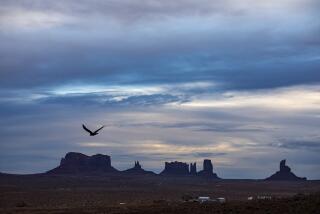Wall of Water Roars Through Indian Village in Grand Canyon
- Share via
TUBA CITY, Ariz. — The small Havasupai Indian tribe, which makes its home at the bottom of the Grand Canyon, was struggling to save its remote village Wednesday after a rainstorm sent a 12-foot wall of water through the canyon.
The flood, which hit late Monday, destroyed two homes, damaged a dozen others and killed an undetermined number of horses, the only means of transportation for food, goods and mail, Bureau of Indian Affairs officials said.
No injuries were reported, but 60 tourists were flown out by helicopter Tuesday and 107 elderly Havasupai were flown to the Hualapai Indian Reservation 80 miles away on the south rim of the Grand Canyon.
“I’ve talked to people who’ve lived there all their lives, and they say this is the worst they’ve seen it,” said George Keller, Bureau of Indian Affairs superintendent at Valentine, Ariz.
Supai, the Havasupai people’s only village, is considered the most remote Indian town in the continental United States. The only way in and out is an eight-mile-long pack horse trail or by helicopter.
The village is 69 winding Colorado River miles west of the Phantom Ranch, a popular tourist stop below the South Rim, and 12 miles into Havasu Canyon, south of the river.
Supai, home to about 800 Havasupai Indians, is considered one of the more picturesque spots in Arizona, with its world-renowned blue-green water flowing over three waterfalls hundreds of feet high and all contained within the depths of the Grand Canyon.
Keller said more rain was expected, raising concerns that three nearby dams on the plateau above could overflow and send more water cascading into the canyon.
On Tuesday, the Coconino Country Board of Supervisors declared the flood site a disaster area, opening the way to call in Arizona National Guard helicopters.
More to Read
Sign up for Essential California
The most important California stories and recommendations in your inbox every morning.
You may occasionally receive promotional content from the Los Angeles Times.













